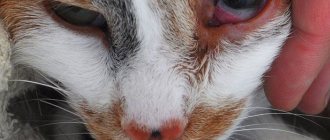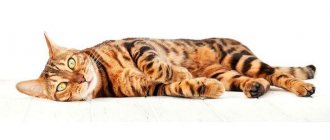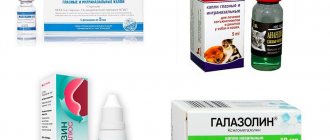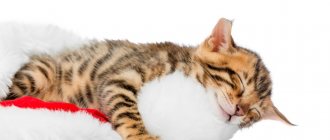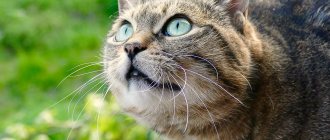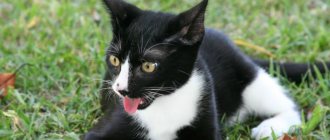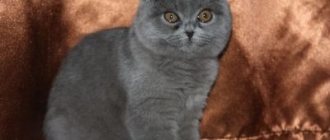12449Administration
Many owners often wonder why their cat sneezes and his eyes water. Some consult with a veterinarian, others try to overcome it on their own by washing the eyeball with herbal or tea infusions, while others hope that it will go away on its own.
Often the owner still pays attention to the fact that the animal is sneezing. If it sneezes due to dust particles getting into the nasal passage, then there is no need to worry. But when a runny nose and sneezing become permanent, it is necessary to figure out why the animal is sneezing and eliminate the disease.
Tears in animals perform a protective function, which is similar to the processes occurring in humans. Tears appear if dust or speck gets in. This is normal. But if the cat behaves restlessly and the flow of tears continues for a sufficient time, then this process must be stopped.
© shutterstock
If a cat’s eyes are watery and sneezing at the same time, then these are good reasons to seek help from a doctor.
The main causes of sneezing and watery eyes in cats
Sneezing and lacrimation in cats most often occurs when a foreign body enters the nose or eyes. However, in some cases, a runny nose in combination with conjunctivitis is a sign of the development of various dangerous diseases in the cat’s body.
The most common reasons why a cat sneezes and his eyes water:
- Allergic reaction. An allergy attack in a cat usually manifests itself after direct contact with an allergen: pollen, deodorants and perfumes, various household chemicals, tobacco smoke. An allergic reaction can be easily recognized by frequent sneezing, as well as shortness of breath, skin rashes and vomiting.
- Colds. When you have a cold, in addition to sneezing and tearfulness, your pet develops snot, coughing, and elevated body temperature.
- Eye injuries. Excessive tearing can occur in cats due to eye injuries. In case of minor damage, it will be enough to rinse the eye with a special antiseptic solution. If the organ is seriously injured, you need to show your pet to a veterinarian.
- Asthma. With asthma, in addition to watery eyes and sneezing, your pet may experience breathing problems, hoarseness, attacks of dry cough, weakness and apathy.
- Viral leukemia. This disease is extremely dangerous for the life of cats and, unfortunately, it manifests itself only when the number of leukocytes in the blood exceeds all permissible norms. As a rule, with viral leukemia in cats, drowsiness, apathy, drooling, excessive discharge from the nose and eyes, pallor of the mucous membranes, and enlarged lymph nodes are observed. If the virus affects the bone marrow, it is no longer possible to help the pet. However, regular examination by a doctor will allow you to detect leukemia at the initial stage and prolong your cat’s life as much as possible.
- Problems with teeth and gums. With various dental diseases, in addition to refusal to eat and weight loss due to pain, the cat may also sneeze frequently.
- Parasites. Worms in the lungs often present with symptoms that closely resemble a cold. So, the pet experiences lacrimation, vomiting, diarrhea, deterioration of the coat, and weight loss.
- Oncology. In the rarest cases, constantly watery eyes and sneezing are symptoms of cancer. In addition to these signs, the owner may notice a loss of smell and weight in the pet, and spotting.
- Polyps. New growths in the nose often cause sneezing, excessive nasal discharge, snoring, head shaking, and even loss of coordination. A cat can have polyps from birth, but sometimes they appear as a result of an untreated infectious disease or allergy. As polyps grow, they cause more and more discomfort for the pet, so they have to be removed surgically.
- Feline immunodeficiency virus (FIV). Feline immunodeficiency virus attacks the pet's immune system. As a result, the cat can get sick and die from any infectious, fungal disease or even oncology. The acute stage of FIV manifests itself approximately 1.5 months after infection in the form of fever up to 40°C, enlarged lymph nodes, diarrhea, weakness, watery eyes, sneezing, and various skin problems. Most often, FIV is diagnosed after several years, when the symptoms of the disease disappear, but various chronic diseases gradually develop. Unfortunately, at this stage it is no longer possible to help the cat.
- Infectious diseases. If a cat sneezes and its eyes water, this may be a symptom of dangerous infectious diseases. Such signs are characteristic of rhinotracheitis, chlamydia, calcivirosis, which are transmitted by airborne droplets and pose a danger to both the pet and its owner.
- Eye diseases. With conjunctivitis and other eye infections, the mucous membrane of the cat's visual organ becomes inflamed, the eyelids swell, pus is released, lacrimation and itching appear. Symptoms of serious diseases such as glaucoma and cataracts, which develop due to improper metabolism, are decreased visual acuity, clouding of the lens and lacrimation.
Rhinotracheitis
Rhinotracheitis is an acute infectious disease that affects the visual and respiratory organs of domestic felines.
Cats of all breeds and ages are susceptible to this disease, regardless of region of residence, but young cats become infected with it more often. Rhinotracheitis is considered a seasonal disease and is most often recorded in the autumn-spring period.
The source of this disease is sick and recovered cats, which are capable of infecting other animals for another 8–9 months after recovery. The causative agent of rhinotracheitis enters the environment through secretions from the nose, eyes, genital tract, as well as through mother’s milk, urine and feces. A cat can become infected with this disease not only through direct contact with a virus carrier, but also through shared care items, toys, food, and even through the owner.
The incubation period of rhinotracheitis lasts from 3 to 8 days. The disease can occur in acute, subacute and chronic forms. Acute rhinotracheitis is characterized by the following symptoms:
- The cat’s body temperature rises to 40°C within 2–3 days.
- The pet is drooling.
- Small ulcers form on the top of the tongue.
- The cat's eyes begin to water, and purulent contents constantly flow out of the nose.
- Hoarseness, coughing, shortness of breath appear, and the pet begins to sneeze frequently.
- The mucous membranes of the mouth and nose swell and turn red.
In the subacute form, the disease occurs with the same symptoms, but much milder.
With proper treatment, recovery from acute and subacute rhinotracheitis occurs within 7–10 days. Cats that have recovered from the disease acquire long-term immunity from this disease.
In the chronic form of the disease, the cat experiences constant problems with the gastrointestinal tract and a runny nose. Untreated acute and subacute rhinotracheitis quickly becomes protracted.
Complications that can appear at any time pose a great danger to the life and health of a cat:
- bronchitis;
- pneumonia;
- feline leukemia;
- ulcerative keratitis;
- damage to the central nervous system;
- the likelihood of miscarriage and stillbirth of kittens.
Chlamydia
Chlamydia is an infectious disease that affects the upper respiratory tract and eyes, and in rare cases, the genitals and gastrointestinal tract of a cat.
Most often, this disease affects kittens between 5 weeks and 9 months of age. However, sometimes adults also get it.
Chlamydia infection occurs through direct contact with a sick cat or by sniffing its urine or feces. Also, the causative agent of the disease, chlamydia, can be brought from the street by the owner on his clothes and shoe soles. Babies can become infected with chlamydia while still in the womb.
The incubation period of the disease lasts from 7 to 10 days. The initial stage of chlamydia is characterized by the following symptoms:
- unilateral conjunctivitis;
- photophobia;
- nasal discharge;
- profuse lacrimation;
- cough;
- dyspnea.
If treatment is inadequate or the cat does not see a doctor in a timely manner, the cat may develop bilateral conjunctivitis, and discharge from the eyes will become purulent.
It is not at all difficult to cure chlamydia, but you must strictly follow all the doctor’s recommendations. Otherwise, the cat risks completely losing its vision. In addition, chlamydia can become chronic, and the pet will become a permanent asymptomatic carrier of this disease.
Calicivirus
Calcivirus infection of cats is an extremely contagious and dangerous viral disease that affects the mucous membrane of the mouth and upper respiratory tract.
Absolutely any domestic member of the cat family can become ill with calcivirus, regardless of age, gender, breed and place of residence. However, young individuals aged 1 month to 2 years are most susceptible to this disease, because their immunity is not yet strong enough to resist infection. Unfortunately, calcivirus infection in a kitten is much more complex and faster than in an adult animal. If you do not consult a doctor in a timely manner, the baby may die 2-3 days after the first symptoms appear.
The Feline Calicivirus virus, the causative agent of calicivirus, penetrates into the environment through discharge from the eyes and nose, urine, feces, and saliva of a sick animal. The infection is transmitted to a healthy cat from a sick cat during their direct contact, as well as through shared care items. In addition, clothing, shoes, and even the hands of an owner who has previously been in contact with a sick animal can become a source of infection.
The incubation period of calcivirosis usually lasts from 2 to 10 days. The cat then develops the following symptoms:
- cough;
- runny nose;
- sneezing;
- temperature increase up to 40°C;
- salivation;
- the appearance of ulcers on the nose, lips and palate;
- vomit;
- diarrhea;
- bad breath.
If the disease is detected at the initial stage, the pet can be treated at home: place it in quarantine and strictly follow all the veterinarian’s recommendations. Otherwise, the cat will develop extremely dangerous complications, which in 90% of cases lead to death due to pneumonia, bronchitis, dehydration or brain damage.
A cat that has suffered from calcivirus once receives immunity for life. However, the causative agent of this disease has the ability to mutate, so if a new strain appears, she may well get sick again.
Other Possible Causes
Quite often, the causes of excessive lacrimation in cats are physiological, namely:
- Individual characteristics of the breed. For some cat breeds, lacrimation is normal. It appears due to the special structure of the skull, flattened nose and naturally deformed nasolacrimal ducts. Typically, excessive tearing after sleep is observed in Sphynx, British, Scottish and Persian cats. Owners of these representatives of the cat family need to pay more attention to eye and nose care.
- Pet's age. Newborn kittens who have recently opened their eyes are characterized by profuse lacrimation. Usually the mother cat washes them for babies, but if she is not nearby, the owners can periodically wipe the kittens’ eyes with warm boiled water.
In these situations, the owner should not panic, but provide his furry pet with more thorough care.
Tips for beginners when washing eyes
Eye washing is one of the most important points in the treatment and prevention of disease in any animal.
You can do the procedure yourself at home or go to a veterinary clinic. During a period of illness, a cat is most often reluctant to allow its owner to approach it.
Representatives of the Persian, British and Siamese breeds are especially capricious. In this situation, it is advisable to ask a family member to hold the cat's head during the procedure. It is best to secure it with a towel or diaper.
Recommendations:
- A folded cotton pad or a tight tourniquet is suitable for rinsing. It is better to avoid cotton swabs, as they do not absorb liquid well, have a relatively small surface and can damage the retina when the animal tries to escape.
- For sterility purposes, it is better to prepare separate dishes for washing each eye. For the same reason, you should use a cotton pad no more than once.
- It is not recommended to touch the inflamed surface with a dry disc.
- Hands must be washed.
- All solutions must be at room temperature.
- Keep in mind that a swollen area can often cause pain for your cat.
- The best treatment is comprehensive. After rinsing with the solution/drops, re-treat the inflamed area with ointment.
- You need to repeat washing as often as possible. Step-by-step instructions for washing eyes
- Fix the animal on its side, turning its head up, holding the chin.
- If a crust forms and the eye sticks together, soften the inflamed area with Vaseline oil. Using cotton wool soaked in 3% hydrogen peroxide, remove the discharge, then rinse with the solution and apply eye drops.
- Apply the solution to the eyeball, gently lifting the eyelids.
- Raise and lower the animal's eyelids several times to distribute the medication evenly. Remove excess with a disc.
- Do not forget about nasal discharge, remove it with a cotton pad.
What to do if your cat is sneezing and her eyes are watering
The best thing an owner can do if their cat or kitten is sneezing and their eyes are watering is to take their pet to the vet as soon as possible. Self-medication can significantly worsen the animal’s condition, because no owner can make a correct diagnosis without special diagnostics and laboratory tests. In addition, some cat diseases can be transmitted to humans.
Dangerous accompanying symptoms
If the following alarming symptoms appear in a constantly sneezing pet, you should urgently take him to the veterinarian:
- Excessive swelling of the oral mucosa, which makes breathing significantly more difficult.
- Bloody discharge from the nose.
- Vomiting and diarrhea.
- Change in eye color, clouding.
- Excessive weight loss.
- Ulcers and other skin rashes.
- Copious discharge of pus from the nose, ears and eyes.
- Too lethargic or, conversely, an excited state.
- Prolonged fever.
- Constant watery eyes, itching and irritation in the eye area.
Important! If a cat picked up on the street sneezes and has snot, you should also show it to a doctor to avoid infecting other pets in the house.
Differences from a human runny nose
Rhinitis is a disease caused by inflammatory processes affecting the mucous membranes of the nasopharyngeal sinuses.
A characteristic sign of a runny nose is copious discharge from the nostrils. They can be transparent and cloudy, colorless or yellowish-green (sometimes mixed with blood), liquid or viscous-thick.
In cats and humans, the signs of a runny nose are identical.
Rhinitis can be unilateral or bilateral, short-term or prolonged.
The main difference lies in the factors that provoked problems with the nose. If in humans the main reason lies in allergic reactions to irritants and the penetration of a viral infection into the nasopharynx, then in animals the “culprits” are more serious and dangerous.
Diagnostic methods
When contacting a veterinarian with complaints of sneezing and lacrimation, a specialist will definitely examine the cat’s mouth and throat, measure the temperature, palpate the lymph nodes and abdominal area. In addition, the doctor will question the owner in detail about the lifestyle his pet leads and what the first symptoms of the disease were.
Next, the cat will be prescribed the following diagnostic procedures:
- General and biochemical analysis of blood and urine;
- throat and nasal swab;
- X-ray of the head;
- endoscopy of the nasal passages.
Based on the tests and studies, the specialist will diagnose the cat and prescribe the necessary treatment, taking into account the characteristics of its body.
Worm infestations
Worm infestations that constantly threaten cats can cause sneezing: toxoplasmosis, dirofilariasis.
In the acute form of toxoplasmosis, the cat becomes lethargic, refuses to eat, has a high body temperature, coughing, sneezing, runny nose, lacrimation, shortness of breath, and heavy wheezing breathing. When the nervous system is involved in the pathological process, the cat develops convulsions, muscle tremors, twitching, and in severe cases, paralysis. Sometimes there is a disturbance in the functioning of the gastrointestinal tract (vomiting, diarrhea, constipation). If the liver is damaged, there is an icteric discoloration of the visible mucous membranes. More details about toxoplasmosis in the article – toxoplasmosis in cats.
Dirofilariasis (heart parasites transmitted by mosquito bites) develops in the heart muscle and leads to sneezing, dry cough, shortness of breath similar to asthma, increased fatigue, weight loss, heart failure, upon auscultation - heart murmurs, rapid heartbeat. Read more about this disease in our article - dirofilariasis.
Treatment
The choice of treatment method directly depends on the cause that provoked the development of the disease:
- Removal of a foreign body from the respiratory tract of a mustachioed pet will most likely have to be carried out by a specialist using an endoscope. In the future, depending on the cat's condition, she may need to take anti-inflammatory medications.
- In case of allergies, the doctor will prescribe antihistamines to the animal. The owner will also need to carry out wet cleaning of the apartment more often and try to completely eliminate contact with allergens.
- Relieving a cat of a cold is carried out using physiotherapy, nasal rinses, antiviral, antibacterial and immunomodulating drugs. The animal's eyes are washed with furatsilin solution 3 times a day, and vasoconstrictor and anti-inflammatory drops are instilled into the nose.
- A pet with asthma will need constant use of glucocorticosteroids, and in case of a bacterial infection, also antibiotics. If all instructions are followed, the cat will be able to live a long and fulfilling life.
- With a confirmed test for helminths, the cat will be prescribed narrow-spectrum antihelminthics.
- If a cat is diagnosed with a malignant tumor, she will need surgery and then maintenance therapy.
- To remove polyps, the pet will also have to undergo surgery. Further recovery usually occurs without complications.
- Treatment of conjunctivitis and other eye diseases is carried out by washing with a weak solution of furatsilin or potassium permanganate. Subsequently, Levomycetin, Sodium Sulfacyl, Kanamycin, Sofradex are instilled into the cat’s eyes.
- Viral and infectious diseases are treated with antiviral drugs or antibiotics in the form of tablets and injections. In addition, to strengthen the immune system, cats are prescribed immunomodulators and vitamin complexes.
To treat a runny nose in combination with conjunctivitis in mustachioed pets, drops are most often used:
- anti-inflammatory and wound healing Anandin;
- immunostimulating and anti-inflammatory Maxidin;
- Thymogen, which is similar in its action to Maxidin;
- antiseptic and vasoconstrictor Naphthyzin and Nazivin;
- antiseptic Dioxidin.
For acute keratitis, purulent conjunctivitis, blepharitis, corneal ulcers and other severe eye lesions, cats are prescribed drops:
- Diamond eyes;
- Leopard;
- Iris;
- Tsiprovet.
The result of treating lacrimation, runny nose and sneezing also depends on whether the drug was administered correctly. Owners are advised to follow the following recommendations:
- Securely secure the cat with a towel.
- Clean the eye from accumulated secretions with a cotton pad that has been soaked in a solution of furatsilin, potassium permanganate or a decoction of medicinal herbs.
- Pull back the eyelid and instill the medicine.
- Hold your pet in your arms for at least 5 minutes so that the drug is absorbed.
- Praise your cat and treat her with her favorite treat.
To properly administer nasal drops to a pet, the owner will also have to follow some recommendations:
- Fix the cat's face strictly vertically. The thumb of the left hand should rest on the chin, and the index finger should rest on the pet’s forehead.
- Take the bottle of medicine with your right hand.
- Bring it closer to the nose at a distance of 2–3 mm, quickly inject the contents.
- Praise your pet and pamper him with something tasty.
In some cases, traditional methods can be used to combat lacrimation and sneezing, but they must be agreed upon with the attending physician:
- Instillation of various infusions or vegetable juices into the nose.
- Warming the nose with previously collected and heated salt in a bag.
- Rinse the nose with a solution of salt or soda using a syringe without a needle.
What can be the consequences of rhinitis?
As a rule, if a cat does not breathe through its nose, one of the causes of respiratory dysfunction is rhinitis. Moreover, unlike people, a runny nose in furry pets in most cases is not a separate disease, but rather a symptom of a serious illness or infection.
Symptoms of rhinitis in cats:
- increased body temperature;
- weakness, drowsiness, general malaise;
- enlargement of regional lymph nodes;
- cough, shortness of breath, sneezing;
- copious discharge from the nostrils and eyes;
- redness, changes in the nose;
- the presence of ulcers, crusts, scabs on the nose;
- decreased appetite, refusal to feed.
With purulent rhinitis, purulent viscous exudate of yellow, yellow-green color is released from the nasal passages. The cat constantly rubs its face with its paw, sneezes, cannot sleep normally, and is restless. Dry crusts and scabs are noticeable on the lobe. At the same time, the amount of discharge from the nasal passages increases after sleep and during physical activity. When auscultating the sternum, wheezing and wheezing are heard. Breathing is rapid and shallow.
In addition to the symptoms listed above, cats may have other manifestations. It all depends on the root cause that caused the cat’s runny nose or stuffy nose.
A runny nose and inflammation of the mucous membranes should be treated promptly; there is no need to wait for complications for the pet to become deaf or for the inflammation to spread to other respiratory organs.
- If rhinitis occurs due to an infection, bacterial or viral, the veterinarian prescribes antibiotics and antibacterial drugs, taking into account the animal’s age and breed. It is important to strictly adhere to the instructions and carry out the course of treatment to the end, even if there is no discharge and the nose can breathe freely.
- The course of treatment for rhinitis may include antipyretic, anti-inflammatory, and sedative drugs.
- Sometimes the veterinarian recommends rinsing the animal’s nose to ease its breathing and general condition.
- Inhalations with essential oils are effective for rhinitis; you just need to strictly follow the dosage of oil drops. The nose is also warmed up with warm sand or salt wrapped in a clean cloth.
- If your pet has dry skin around its nose, you can constantly moisturize it with baby cream or Vaseline.
If you need to clear your nose, you should act very carefully and carefully, following the advice of experts. Wounds can not only cause pain, but also become a source of infection. You can clean the crusts with a damp cotton swab.
An irresponsible cat owner can rely on a miracle and wait for the pet’s runny nose to go away on its own. But congestion and discharge, inflammation associated with colds or allergies, need to be treated and only as prescribed by a doctor.
If an animal does not breathe well, it does not receive the required amount of oxygen. Because of this, appetite and general condition worsen, and the body becomes exhausted. Acute rhinitis, with inactivity, becomes chronic, and it is much more difficult to treat.
What can you do at home?
Here's how you can help your cat:
- Ensure a comfortable temperature in the room where the cat lives, because overheating, like hypothermia, has a negative effect on its body. It is also important to avoid low humidity, since in this case the pet’s mucous membranes dry out and cease to protect the animal from bacteria and dust. As a result, pathogens penetrate the body faster.
- Avoid dehydration, which often occurs when the temperature rises and the cat completely refuses water. The owner will have to force-feed the pet from a syringe. If it is not possible to get him to drink in this way, it is allowed to administer saline or Ringer's solution intravenously.
- Force feed your pet if it refuses food for 3 days or more. You can offer your cat food that is not too heavy: high-quality wet food, finely chopped boiled chicken liver, low-fat broth, cottage cheese. In addition, you can try to stimulate your cat's appetite with food with a distinct smell.
- Introduce vitamins into your pet's diet. It is better to give preference to drugs in the form of injections, since the absorption of nutrients at this time is reduced.
- Use only those medications prescribed by your doctor to treat your cat.
Important! A cat should receive at least 50 ml of liquid per day, including liquid food, per 1 kg of its weight.
How to help your pet?
If there is no way to get the cat to the clinic immediately, the owner must help it himself. This is not a treatment, but perhaps your pet’s well-being will improve for a while.
When a cat's eyes become very festered, the eyelids stick together, the hairs become wet, and wet tracks are visible on the nose - all this leads to the rapid growth of pathogenic bacteria and itching. Therefore, the pus needs to be removed and the eyes washed, avoiding the accumulation of exudate. For rinsing, use a sterile gauze swab and neutral lotions, boiled water, a weak (slightly pinkish) solution of manganese, furatsilin or chamomile decoction.
The inflamed conjunctiva needs to be handled with care, so the liquid should not contain solid particles, and cotton wool should not be used (the fibers irritate the eyes). The drug must be warmed to room temperature. When removing discharge from the fur around the eyes, under no circumstances put pressure on the eyelids.
After the pus has been removed from the cat's eyes, apply antiseptic, anti-inflammatory, and anti-swelling drops. Lacrimin, Anandin, Tsiprovet, IRIS are suitable as “home” remedies. Drops are used twice a day, following the dosage (in the instructions) and only after removing the crusts and washing the eyes.
If after two days the cat's eyes are still festering, a veterinarian will prescribe treatment. You should consult a doctor immediately if other symptoms of illness appear, even with a visible improvement in the condition of the eyes (for example, drops can remove inflammation, but the virus continues to destroy the health of your pet).
Prevention
Cat owners should make every effort to avoid watery eyes, sneezing, and snot. Compliance with the following recommendations will reduce the likelihood of contracting various infectious diseases, and will also help eliminate other causes that can cause increased tearfulness and sneezing:
- Vaccination of kittens from a very early age, compliance with the vaccination schedule for adult cats.
- Providing a balanced diet.
- Minimizing the cat's contact with animals that can be sources of serious diseases.
- Preventing your pet from hypothermia.
- Regular cleaning using disinfectants in the apartment where the cat lives.
- Quarterly treatment of your pet for internal and external parasites.
- Preventing your cat from accessing possible allergens.
Watery eyes and sneezing are most often symptoms of various pathologies. A loving and responsible owner should carefully monitor any changes in the health status of his pet, and if necessary, be sure to show him to a doctor. After all, the sooner the reason why a cat is sneezing and her eyes are watering is found and eliminated, the faster she will recover and return to normal life.
Green snot is a danger signal
Rhinitis (inflammation in the nasal passages) occurs in cats due to the impact of various unfavorable factors on the nasal mucosa. Because of this, special glands begin to secrete a special protective secretion in much larger quantities than usual. This secretion - a mucous liquid flowing from the nostrils - is what we used to call snot.
If you notice any discharge from your cat's nose, you should definitely consult a veterinarian. Without establishing the exact cause, it will not be possible to help the animal. Self-medication is not advisable, because only a specialist can determine the cause and tell you what to do if your cat has snot. This problem can only be eliminated if the root cause is eliminated. Only a specialist can tell you how to treat a runny nose in a cat!
Green snot signals the addition of bacterial microflora. It could be as follows:
- streptococci;
- staphylococci;
- Pseudomonas aeruginosa;
- pneumococci.
These are the main bacteria that cause your pet to snot. But there may be other pathogenic microorganisms. The green color is formed due to the proliferation of bacteria, the action of the immune system, which secretes lymphocytes and inflammatory mediators. The greater the immune response, the greater the swelling and exudate.
Gradually, rhinitis with green snot becomes more complicated, leading to the following diseases:
- rhinitis;
- sinusitis;
- sinusitis;
- pharyngitis;
- frontitis.
Purulent exudate can pass not only into the sinuses, but down the respiratory system. First, pharyngitis appears, which then develops into tracheitis, bronchitis and pneumonia. This condition is common, especially in cats with reduced immune reactivity.
Purulent exudate has a thick structure, so it often completely clogs the nasal passages. The pet begins to breathe heavily and snore in its sleep. In severe cases, body temperature rises.
In rare cases, the infection can travel throughout the body, causing infectious inflammation of the kidneys, bladder, and even the brain.
Attention! If antibacterial drugs are not given to the animal in a timely manner, bacteria can enter the bloodstream, causing sepsis and death without first aid.
